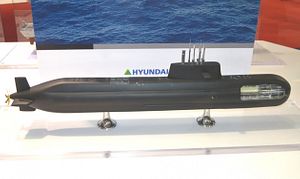South Korea will launch the first of a planned fleet of nine 3,000-ton indigenously designed KSS-III (Jangbogo–III-class) diesel-electric submarines next month, according to local media reports. The submarine will be launched at the Daewoo Shipbuilding and Marine Engineering (DSME) shipyard on Geoje Island, near the port city of Busan in the southeastern part of South Korea, next month.
The keel laying ceremony of the first KSS-III diesel-electric submarine took place at the DSME shipyard on Geoje Island in May 2016 with construction intermittently delayed due to technical issues. The first-of-class boat is expected to be handed over to the Republic of Korea Navy (ROKN) by the end of 2020 or early 2021 following two years of builder sea trials.
The entire KSS-III class of subs will be produced in three batches. The first batch will include three boats, each fitted with six vertical missile tubes with the first two submarines to be assembled by DSME and the third to be built by South Korean shipbuilder Hyundai Heavy Industries (HHI). The first three boats are expected to be operational by the early 2020s.
The next batch of three submarines, also fitted with a six-tube vertical launch system, is slated to be deployed by 2025, while the last three boats, reportedly boasting a displacement of over 3,500 tons and equipped with 10 vertical launch tubes each, will all be delivered to the ROKN by 2029. Each batch will reportedly see a gradual increase in the number of indigenous components used for the various sub-systems of the boats.
All nine subs will feature indigenous combat management and sonar systems. The new submarine class will also be fitted with air-independent propulsion powered by South Korean lithium-ion battery technology. Furthermore, the boats will also be equipped with the Korean Vertical Launch System. KSS-III subs will be the first ROKN boats to have the capability to vertically launch ballistic or cruise missiles.
Notably, South Korea has been working on a new submarine-launched ballistic missile (SLBM) for the KSS-III class. The new missile will likely be a variant of the Hyunmoo-2B or the Hyunmoo-2A. The subs will also be capable of firing Hyunmoo-3C cruise missiles. As I reported elsewhere:
The Hyunmoo 2A surface-to-surface missile has an estimated range of 300 kilometers, whereas the more advanced Hyunmoo 2B — first test-fired in June 2015 — has an approximate maximum range of 500 kilometers (310 miles) and is capable of carrying a payload of up of up to 997 kilograms (2,200 pounds).
The Hyunmoo 3B and 3C surface-to-surface cruise missiles have an estimated range of 1000 and 1,500 kilometers (932 miles) respectively. While Hyunmoo cruise missiles have a higher accuracy, the destructive capability of the ballistic variant is substantially greater.
The KSS-III class is part of the ROKN’s three-phased Korean Attack Submarine construction program. The first phase consisted of procuring nine 1,200-ton KSS-I Chang Bogo-class diesel-electric attack submarines – a variant of German Type 209 boats. The subs of the class are currently being retrofitted with air-independent propulsion and flank-array sonars. The second phase consists of procuring nine KSS-II Son Won II-class boats, a variant of the Type 214 submarine of Germany’s Howaldtswerke-Deutsche Werft. The last sub of the KSS-II class was launched in September 2017.

































